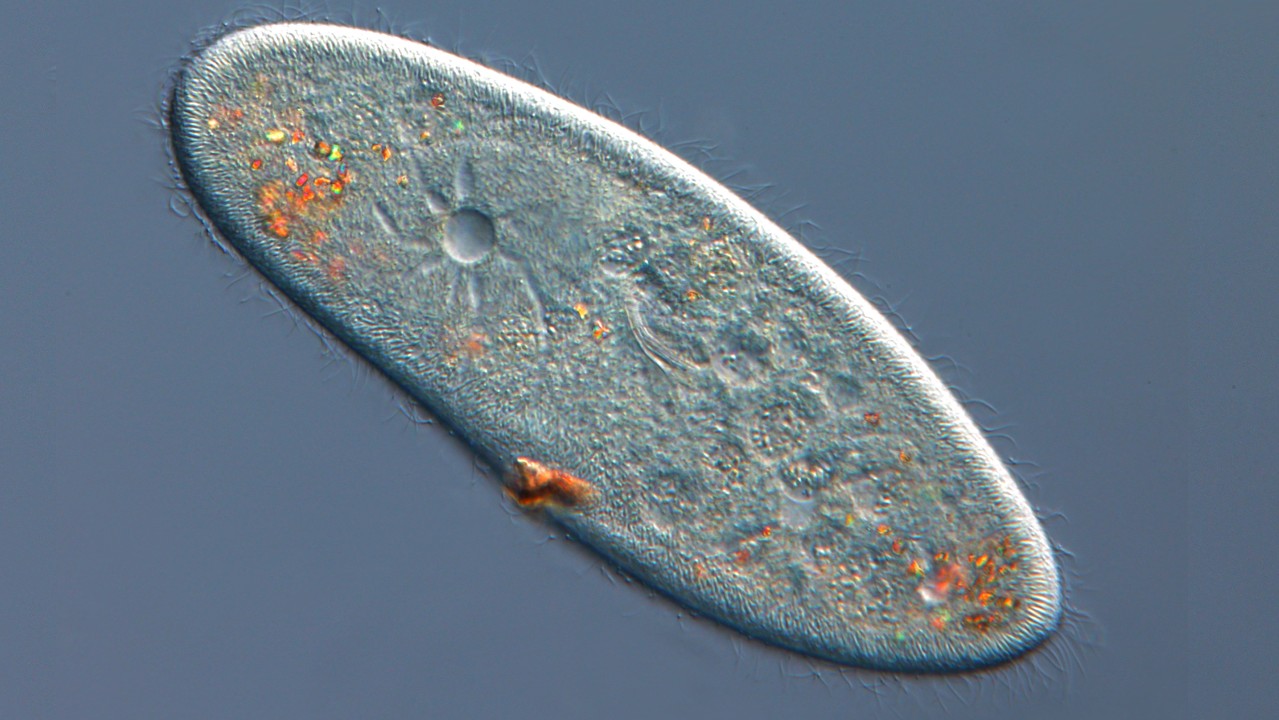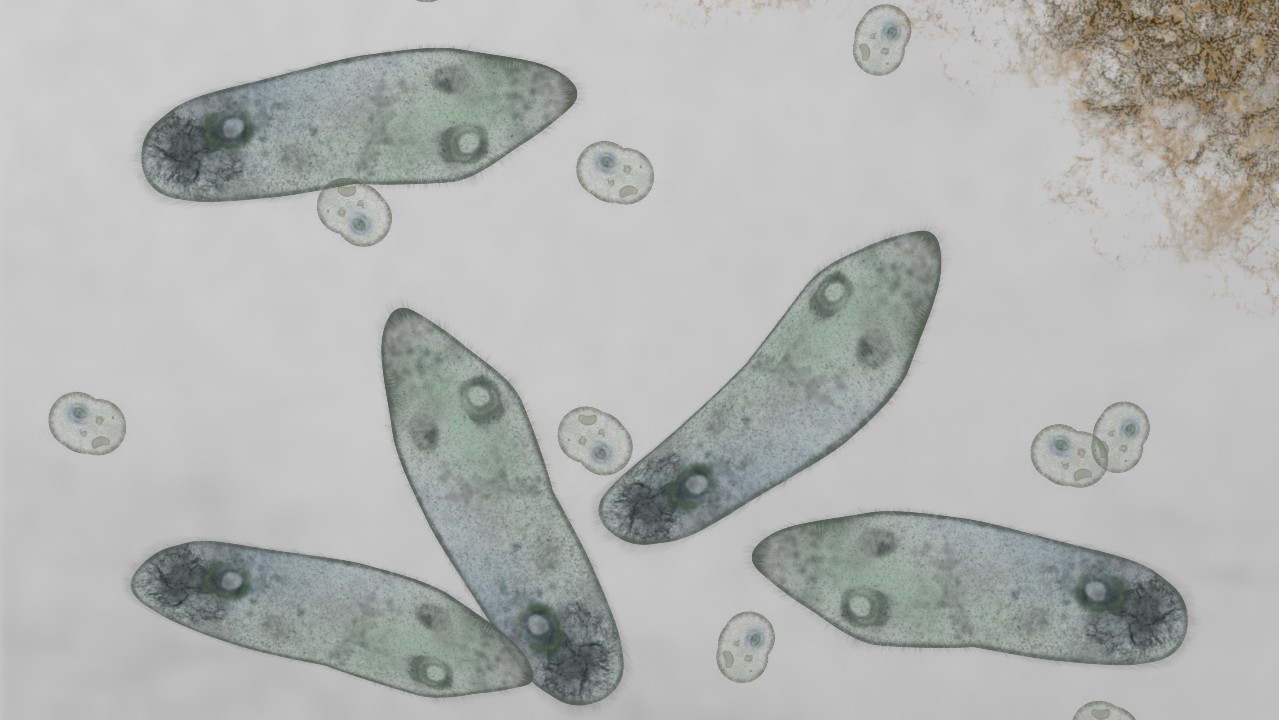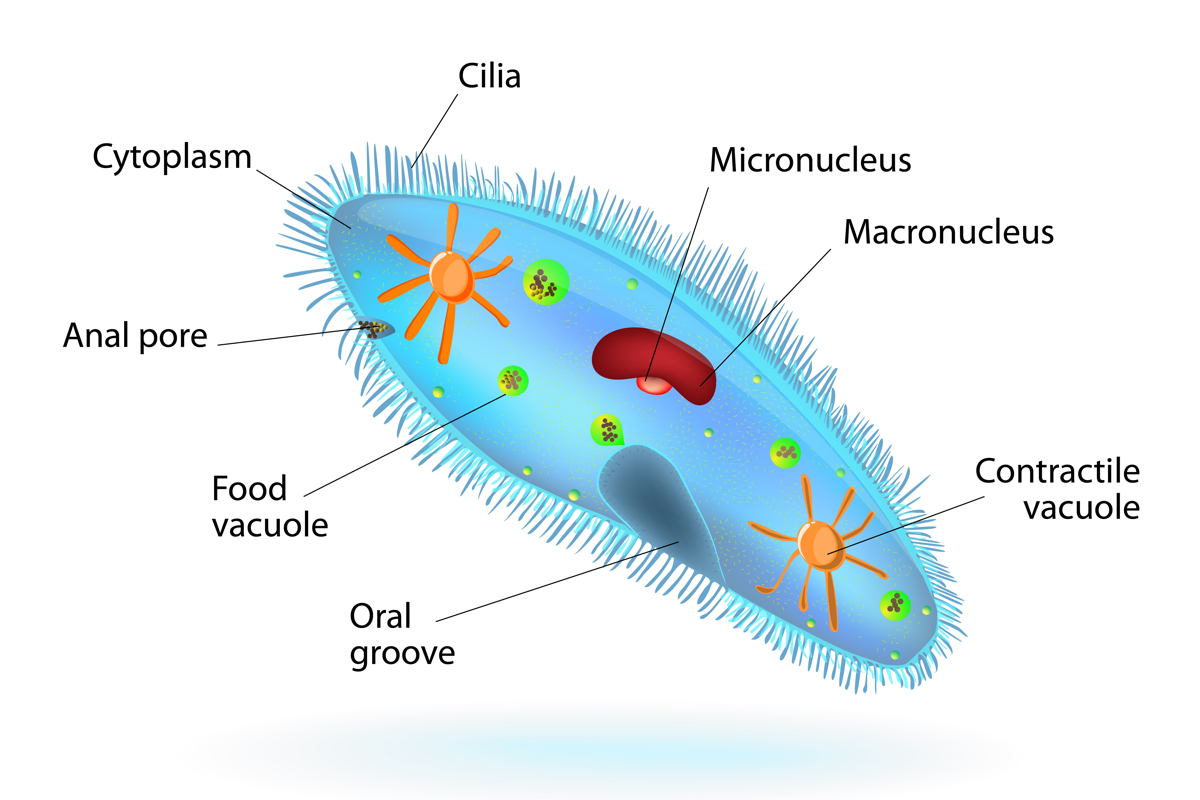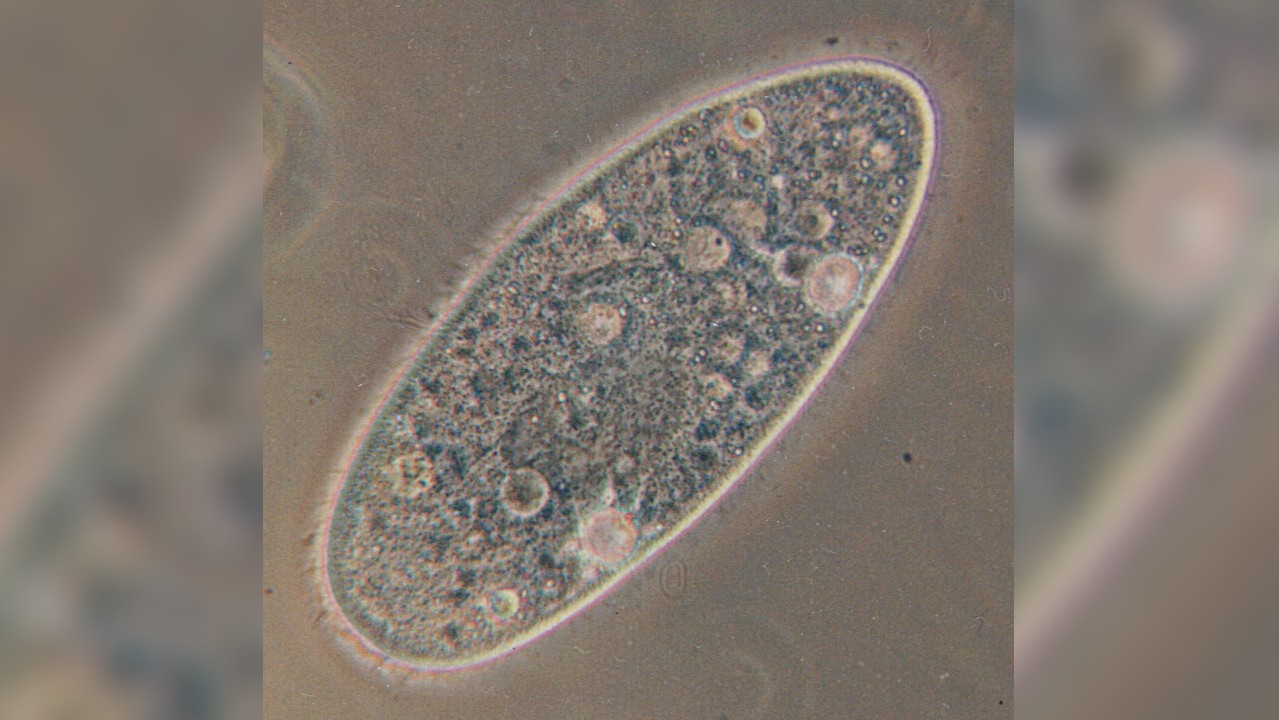Paramecium: Characteristics, biology and reproduction
A paramecium is a microscopic organism that lives in ponds and streams

Paramecium or paramecia are single-celled protists that are naturally found in aquatic habitats. They are typically oblong or slipper-shaped and are covered with short hairy structures called cilia. Certain paramecia are also easily cultured in labs and serve as useful model organisms (a non-human species used to understand biological processes).
Appearance
Paramecia cells are elongated in appearance, and based on this shape were divided into two groups: aurelia and bursaria, according to the "The Biology of Paramecium, 2nd Ed." (Springer, 1986). The aurelia morphological type is oblong, or "cigar" shaped, with a somewhat tapered posterior end. Bursaria, on the other hand, represents cells that are "slipper" shaped. They tend to be shorter, and their posterior end is rounded.
Paramecium are a part of a group of organisms known as ciliates, according to California Institute of Technology. As the name suggests, their bodies are covered in cilia, or short hairy protrusions. Cilia are essential to a paramecium's movement. As these structures whip back and forth in an aquatic environment, they propel the organism through its surroundings.
Paramecia can move forward at rates up to 2 millimeters per second, according to the “Cell Physiology Source Book” (Academic Press, 1995). Sometimes the organism will perform "avoidance reactions" by reversing the direction in which the cilia beat. This results in stopping, spinning or turning, after which point the paramecium resumes swimming forward. If multiple avoidance reactions follow one another, it is possible for a paramecium to swim backward, though not as smoothly as swimming forward.
Cilia also aid in feeding by pushing food into a rudimentary mouth opening, known as the oral groove. Paramecia feed primarily on bacteria, but are known to eat yeast, unicellular algae and even some non-living substances such as milk powder, starch and powdered charcoal, according to "Biology of Paramecium."

Cell structure
Paramecium are eukaryotes. In contrast to prokaryotic organisms, such as bacteria and archaea, eukaryotes have well-organized cells. The defining features of eukaryotic cells are the presence of specialized membrane-bound cellular machinery called organelles and the nucleus, which is a compartment that holds DNA, according to Washington University. Paramecia have many organelles characteristic of all eukaryotes, such as the energy-generating mitochondria. However, the organism also contains some unique organelles.
Under an external covering called the pellicle is a layer of somewhat firm cytoplasm called the ectoplasm. This region consists of spindle-shaped organelles known as trichocysts. When they discharge their contents, they become long, thin and spiky, according to "Biology of Paramecium."
Trichocysts are a network of telescopic organelles that are used to repel and shield from any predatory attacks and propel the paramecium in unpredictable directions, according to Cell Biology magazine. Research published in the journal Zoological Science found that trichocysts of Paramecium tetraurelia were effective against two of the three predators that were tested: the Cephalodella species of rotifers and the Eucypris species of arthropods.
Below the ectoplasm lies a more fluid type of cytoplasm: the endoplasm. This region contains the majority of cell components and organelles, including vacuoles. These are membrane-enclosed pockets, which in plants and animals handle waste product, store water and offer structural support for cells, according to the National Human Genome Research institute Vacuoles take on specific functions with a paramecium cell. Food vacuoles encapsulate food consumed by the paramecium, according to the University of Chicago. They then fuse with organelles called lysosomes, whose enzymes break apart food molecules and conduct a form of digestion. Contractile vacuoles are responsible for osmoregulation, or the discharge of excess water from the cell, according to the authors of "Advanced Biology, 1st Ed." (Nelson, 2000). Depending on the species, water is fed into the contractile vacuoles via canals, or by smaller water-carrying vacuoles. When the contractile vacuole collapses, this excess water leaves the paramecium body through a pore in the pellicle.
Perhaps the most unusual characteristic of paramecia is their nuclei. "Paramecium along with the other ciliates have this rather unique feature," said James Forney, a professor of biochemistry at Purdue University. "They have two types of nuclei, which differ in their shape, their content and function."
The two types of nuclei are the micronucleus and macronucleus, according to the Encyclopedia of Microbiology. The micronucleus is diploid; that is, it contains two copies of each paramecium chromosome. Forney notes that the micronucleus contains all of the DNA that is present in the organism. "It's the DNA that is passed from one generation to the another during sexual reproduction," he said. On the other hand, the macronucleus contains a subset of DNA from the micronucleus, according to Forney. "It is the transcriptionally active nucleus," he added. "So it's the nucleus that is transcribed to make mRNAs and proteins from those mRNAs." The macronucleus is polyploid, or contains multiple copies of each chromosome, sometimes up to 1000 copies, according to Encyclopedia of Microbiology .

All paramecium species have one macronucleus, according to Forney. However the number of micronuclei can vary by species. He gives the example of the Paramecium aurelia species complex, which have two micronuclei and Paramecium multimicronucleatum, which have several.
Why the presence of two distinct nuclei? One evolutionary reason is that it is a mechanism by which paramecium and other ciliates can stave off genetic intruders: pieces of DNA that embed themselves into the genome. "In the case of ciliates, there's a mechanism in which, if a piece of DNA is in the micronucleus but it's not in the macronucleus, it will be removed from the next macronucleus that is made," Forney explained. "In other words, if something foreign got into the micronuclear genome, then when the next macronucleus is made, it would removed and not included in the expressed version [transcribed] of the genome." Forney notes that this has been described by some as a primitive DNA immune system; that is, surveying the genome and trying to keep out invading elements.
Reproduction
Paramecia can reproduce either asexually or sexually, depending on their environmental conditions. Asexual reproduction takes place when ample nutrients are available, while sexual reproduction takes place under conditions of starvation. In addition, paramecia can also undergo "autogamy" or self-fertilization under conditions of prolonged starvation, according to “Building the Most Complex Structure on Earth” (Elsevier, 2013)
Asexual reproduction (binary fission)
During binary fission, one paramecium cell divides into two genetically identical offspring, or daughter cells. According to Forney, the micronucleus undergoes mitosis, but the macronucleus divides another way, called an amitotic, or non-mitotic, mechanism. "It is not based on mitosis but it [macronucleus] divides between the two cells and somehow is able to keep approximately the same number of copies of each gene," he said.
Sexual reproduction (conjugation)
Conjugation among paramecia is akin to mating. Forney said that there are two mating types for paramecia, which are referred to as odd and even. This reflects the fact that the mating types for various paramecium species are denoted by either an odd or even number. For example, according to Forney, Paramecium tetraurelia have mating types 7 and 8. "Odd will mate with the even mating type but you cannot mate if you are the same mating type," he said. Moreover, only cells within a single Paramecium species can mate with one another.
The process is easily distinguishable under laboratory conditions. "The cells stick together. They can actually form rather dramatic clumps of cells when they are initially mixed," Forney said. "Then those gradually pair off into individual pairs in culture."
(Paramecium conjugation. Antonio Guillén, CC BY 3.0)
During sexual reproduction, the micronuclei of each paramecium undergo meiosis, ultimately halving the genetic content to create a haploid nucleus. These are exchanged between the two connected mates. The haploid nuclei from each mate fuse to create a new, genetically varied, micronucleus. In turn, the new micronucleus replicates to give rise to a new macronucleus.
Autogamy (self-fertilization)
"Autogamy is essentially the same thing as conjugation, but it is only happening with a single cell," Forney said. During this process, the micronucleus replicates multiple times. One of these new micronuclei undergo rearrangement of their genetic content. Some DNA is fragmented and some DNA sequences, known as "Internal Eliminated Sequences," are removed, according to the journal Cellular and Molecular Life Sciences.
Classification
The general term "paramecium" refers to a single organism within the genus Paramecium. A genus, refers to a closely related group of organisms that share similar characteristics, according to Encyclopedia Britannica. The genus Paramecium is further divided in groups known as subgenera, which each contain one or more species.
The methods of classifying paramecia have changed over the years. The earliest methods were through visual observation and were based on morphology, ultimately describing all paramecia as either aurelia or bursaria. More recently, classification has combined morphological observation with molecular and genetic information. This has helped to develop a family tree, known as a phylogenetic tree, that represents evolutionary relationships, according to Berkeley University.
This shift from morphology to molecular phylogenetics has affected the understanding of relationships within the Paramecium genus and species diversity, according to Michaela Strüder-Kypke, manager of advanced light microscopy at the Molecular and Cellular Imaging Facility at the University of Guelph in Ontario, Canada. There are five subgenera of paramecia in total ; Chloroparamecium, Helianter, Cypriostomum, Viridoparamecium and Paramecium, according to the journal Diversity.
Strüder-Kypke said that a method of identifying species known as "DNA barcoding" has been used for Paramecium. "Identification of species based on the sequence of a particular fragment of DNA has been referred to as DNA barcoding," she explained. "Just like a barcode in the stores identifies each product, a short DNA sequence that is sufficiently divergent, can identify each species." One such barcode, the cox1 gene, has been "extensively utilized for the genus Paramecium," Strüder-Kypke said.
There are currently 19 recognized morphospecies of Paramecium, according to Strüder-Kypke. She explained that a morphospecies is a species defined only by distinct morphological characteristics, not by genetics or the ability to produce fertile offspring. Of this, 15 sibling species form what is known as the Paramecium aurelia species complex. Sibling species, according to Strüder-Kypke, look alike with no morphologically distinguishing characteristics, but they differ in biochemical and genetic aspects and cannot conjugate with one another. The Paramecium aurelia complex counts as a single morphospecies.

New insights into Paramecium taxonomy and the existence of new species continue to be described even today. The 19th morphospecies,Paramecium buetschlii, was discovered in a freshwater pool in Norway and described in a research published in the journal Organisms Diversity & Evolution. The same paper also described three new "cryptic species" found in Germany, Hungary and Brazil. The authors explain that they were treated as cryptic species because they were difficult to distinguish morphologically from other members of theParamecium genus. However, taxonomic markers in their DNA [DNA barcodes] indicate that they are a separate species.
"The idea is that, if we look in unusual habitats or "under sampled" regions of this world, we may still find new species," Strüder-Kypke told LiveScience.
Uses
Microorganisms, such as paramecium, can be useful tools to monitor water quality, as researchers from the Singapore University of Technology and Design (SUTD) have discovered. To measure pollutants in marine environments, the researchers tracked the movement of paramecium. "We chose paramecia because they are ubiquitous in water bodies and large enough to be seen with a normal camera," Assistant Professor Javier Fernandez at the Fermart Lab at SUTD said in a statement. By tracking swimming speeds and movements, researchers were able to accurately detect the quality and presence of water pollutants, such as concentrations of heavy metals, in a sample. Paramecium swimming speeds declined when pollutants such as heavy metals zinc chloride and copper sulfate and some antibiotics such as erythromycin, were present.
"Taking a sample of water and measuring the speed of paramecia can therefore be used as a straightforward method to assess the drinkability of water without the need for specialised equipment or chemicals," said Fernandez. "Usually, you would need a different test for each pollutant, but paramecia swimming is a global measurement."
Additional resources
For more information about paramecium, check out “Endosymbionts in Paramecium (Microbiology Monographs Book 12)” by Masahiro Fujishima and “Brock Biology of Microorganisms”. To watch paramecium in action take a look at this video produced by the YouTube channel Journey to the Microcosmos.
Bibliography
Iwona, Rzeszutek, et al, “Programmed genome rearrangements in ciliates”, Cellular and Molecular Life Sciences, Volume 77, May 2020, https://doi.org/10.1007/s00018-020-03555-2
Anne-Marie Tassin, et al, ” Paramecium tetraurelia basal body structure”, Cili, Volume 5, Feburary 2016, https://doi.org/10.1186/s13630-016-0026-4
Van Houten J.,”Paramecium Biology”, Evo-Devo: Non-model Species in Cell and Developmental Biology, Volume 68, October 2019, https://doi.org/10.1007/978-3-030-23459-1_13
Plattner H., “Secretory Mechanisms in Paramecium”, Secretory Mechanisms. Masterclass in Neuroendocrinology, Volume 8, April 2020, https://doi.org/10.1007/978-3-030-22989-4_13
Edna s. Kaneshiro, “Amoeboid Movement, Cilia, and Flagella”, Cell Physiology Source Book, Academic Press, 1995, https://doi.org/10.1016/B978-0-12-656970-4.50051-8
Sign up for the Live Science daily newsletter now
Get the world’s most fascinating discoveries delivered straight to your inbox.
Aparna Vidyasagar is a freelance science journalist who specializes in health and life sciences. Aparna has written for a number of publications, including New Scientist, Science, PBS SoCal, Mental Floss, and several others. Aparna has a doctorate in Cellular and Molecular Pathology from the University of Wisconsin-Madison, and also received a master’s degree and bachelor’s degree from the same university.
- Scott DutfieldContributor










